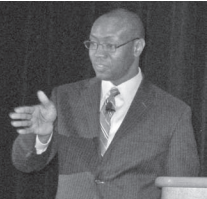
In November 2009, e-mails and other documents were leaked from the University of East Anglia’s Climate Research Unit that caused global-warming skeptics to allege misconduct in the climate-science community and sparked a controversy dubbed “Climate Gate”. Although the overwhelming majority of climate scientists are in consensus concerning climate change, doubt and distractions continue to cloud the discussion of global warming. In his keynote address, J Marshall Shepherd, of the Atmospheric Sciences Program in the University of Georgia’s Department of Geography, examined the current and best scientific thinking on climate change and what we know, what we don’t know, and what we need to know about this important topic.
Even without all the puzzle pieces, said Shepherd, the overall picture on climate change is clear. The average temperature of Earth is about 0.75°C higher than it was in 1860, with March 2010 recorded as the warmest March ever. So if the facts are clear, why the controversy? The answer, noted Shepherd, centers on true understanding of what climate is (and is not) and the fact that global warming is perceived to be not as tangible or imminent, such as the recent swine influenza epidemic.
Climate, Shepherd indicated, is defined as the statistical properties of atmospheric variables, such as temperature, precipitation, and wind. Climate change can be defined as any change in one of those statistical properties, such as mean temperature. Climate change has always occurred and on many time scales—hundreds of billions of years, tens of thousands of years, hundreds of years, and decades. Generally, oscillations over longer periods have greater magnitudes, and climate change varies spatially around the globe. Weather is not climate; and a hot or cold day, week, month, or season is not proof that global warming is or is not occurring.
So what causes our climate to change? And are humans responsible? Factors at work, according to Shepherd, include variations in solar output, Earth’s orbit, land configuration and surface characteristics, atmospheric turbidity, and radiation-absorbing gases. Of those, humans are certainly contributing to increased concentrations of CO2 and other greenhouse gases and to changes in land use, and these factors are responsible for most of the recent global warming. Indeed, according to the 2007 report of the Intergovernmental Panel on Climate Change, most of the global warming of the last 50 years is very likely (odds, 9 out of 10) due to human increases in greenhouse gases.
In a warmer world, more extreme rainfall events (droughts and floods), rises in sea level (up to 1.5 ft by 2100), and more and stronger hurricanes are all likely. Unless we can mitigate those changes, tipping points that cause unstoppable, irreversible climate effects could occur. For example, melting of the Greenland ice sheet could cause a 20-ft increase in sea level, and thawing of the permafrost layer could lead to an increase in the atmospheric burden of global-warming pollutants to up to 10 times the present amount. He noted that commercial ships recently made a voyage from Asia to Europe. In itself that is not strange, except that they made the voyage through the Northeast Passage of the Arctic Ocean.
The new McCarthyism on climate change is eroding solid science, Shepherd concluded. Climate scientists must improve climate models and render them meaningful to policy makers and stakeholders and promote public climate (and overall science) literacy. However, with fewer than 20% of the people on the planet emitting more than 80% of the carbon, it is up to all of us to keep politics and economics from tainting good science and to think about how the discussion or debate is communicated in various forums and formats. Shepherd ended with three words that he says are most important to the debate—consilience, consilience, consilience, which means that many independent groups, different methodologies, and peer-reviewed studies continue to show the same result. Even in the midst of a lot of unpublished chatter.
